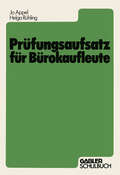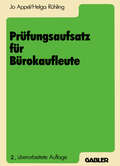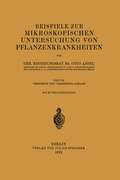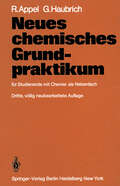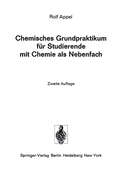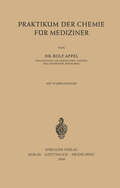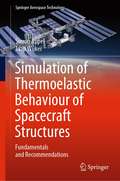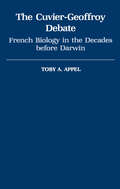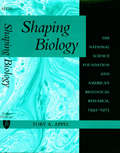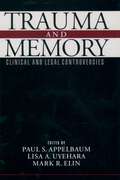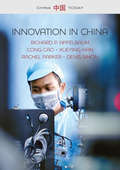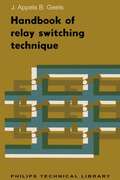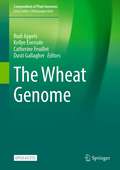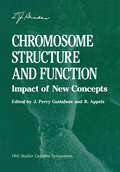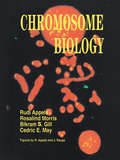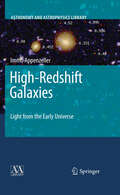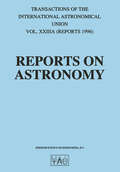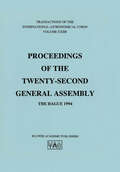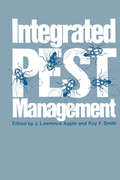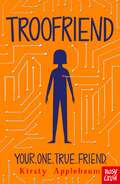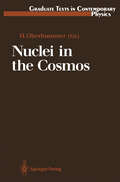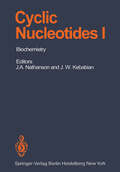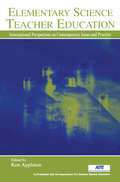- Table View
- List View
Prüfungsaufsatz für Bürokaufleute: Ein Lehr- und Übungsbuch zur Vorbereitung auf die kaufmännische Abschlußprüfung
by Jo AppelPrüfungsaufsatz für Bürokaufleute: Ein Lehr- und Übungsbuch zur Vorbereitung auf die kaufmännische Abschlußprüfung
by Jo AppelDas vorliegende Buch ist für Auszubildende und Schüler gedacht, die sich auf die kauf männische Abschlußprüfung vorbereiten wollen. Erfahrungsgemäß wird der Prüfungsauf satz als recht schwierig empfunden, da auch meistens die Zeit und die Anleitung fehlt, das Aufsatzschreiben gezielt zu üben. Wir möchten gerne mit diesem Buch diese Lücke schließen: Jeder kann sich individuell anhand verschiedener prüfungsrelevanter Themen vorbereiten, denn Schule und Ausbil dungsstätte sind dazu nicht immer in der Lage. Wir legen großen Wert darauf zu zeigen, wie dies gemacht wird. Deshalb haben wir viele Themen gesammelt, aufbereitet und aus gearbeitet, um größtmögliche Hilfestellung zu geben. Jedoch: Dieses Buch ist kein "Nürnberger Trichter". Sie müssen es selbst, intensiv und systematisch bearbeiten. Anleitungen dazu finden Sie genügend. Wir danken den vielen kritischen Lesern für ihre Anregungen, die wir in dieser 2. Aufla ge berücksichtigt haben. ]o Appel Und nun: viel Erfolg! He/ga Rühling 5 Inhaltsverzeichnis AUgemeine Richtlinien zur Anfertigung eines Prüfungsaufsatzes . . . . . . . . . . . 11 . . Teil I: Fachaufsätze über betriebswirtschaftliche Themen . . . . . . . . . . . . . . 13 . . . 1 Die Beschaffung, das Kaufvertrags-, Lager-und Rechnungswesen . . . . . . . . . . 13 . 1.1 Wiederholung des Grundwissens . . . . . . . . . . . . . . . . . . . . . . 13 . . . . . . . 1.2 Fachaufsätze . . . . . . . . . . . . . . . . . . . . . . . . . . . . . . . 20 . . . . . . . . . . . 1.2.1 Der Kaufvertrag . . . . . . . . . . . . . . . . . . . . . . . . . . . 20 . . . . . . . . . Anbahnung - Abschluß - Erfüllung 1.2.2 Einem Kaufmann liegen zwei Angebote vor. . . . . . . . . . . . . . . 22 . . . Schildern Sie, welche Gesichtspunkte ihn beeinflussen können, eines der Angebote als das für ihn günstigere auszuwählen! 1.2.3 Fehlerhafte Ware trifft ein. . . . . . . . . . . . . . . . . . . . . . . 24 . . . . . . . Schildern Sie den Arbeitsablauf vom Wareneingang bis zur Wahrnehmung der Rechte! 1.3 Themen zur selbständigen Bearbeitung . . . . . . . . . . . . . . . . . . . 25 . . . . . . 2 Werbung 26 2.1 Wiederholung des Grundwissens . . . . . . . . . . . . . . . . . . . . . . 26 . . . . . . .
Beispiele zur mikroskopischen Untersuchung von Pflanzenkrankheiten
by Otto AppelDieser Buchtitel ist Teil des Digitalisierungsprojekts Springer Book Archives mit Publikationen, die seit den Anfängen des Verlags von 1842 erschienen sind. Der Verlag stellt mit diesem Archiv Quellen für die historische wie auch die disziplingeschichtliche Forschung zur Verfügung, die jeweils im historischen Kontext betrachtet werden müssen. Dieser Titel erschien in der Zeit vor 1945 und wird daher in seiner zeittypischen politisch-ideologischen Ausrichtung vom Verlag nicht beworben.
Simulation of Thermoelastic Behaviour of Spacecraft Structures: Fundamentals and Recommendations (Springer Aerospace Technology)
by Simon Appel Jaap WijkerThis book provides recommendations for thermal and structural modelling of spacecraft structures for predicting thermoelastic responses. It touches upon the related aspects of the finite element and thermal lumped parameter method. A mix of theoretical and practical examples supports the modelling guidelines. Starting from the system needs of instruments of spacecraft, the reader is supported with the development of the practical requirements for the joint development of the thermal and structural models. It provides points of attention and suggestions to check the quality of the models.The temperature mapping problem, typical for spacecraft thermoelastic analysis, is addressed. The principles of various temperature mapping methods are presented. The prescribed average temperature method, co-developed by the authors, is discussed in detail together with its spin-off to provide high quality conductors for thermal models. The book concludes with the discussion of the application of uncertainty assessment methods. The thermoelastic analysis chain is computationally expensive. Therefore, the 2k+1 point estimate method of Rosenblueth is presented as an alternative for the Monte Carlo Simuation method, bringing stochastic uncertainty analysis in reach for large thermoelastic problems.
The Cuvier-Geoffrey Debate: French Biology in the Decades before Darwin (Monographs on the History and Philosophy of Biology)
by Toby A. AppelFor scientists, no event better represents the contest between form and function as the chief organizing principle of life as the debate between Georges Cuvier and Etienne Geoffroy Saint-Hilaire. This book presents the first comprehensive study of the celebrated French scientific controversy that focused the attention of naturalists in the first decades of the nineteenth century on the conflicting claims of teleology, morphology, and evolution, which ultimately contributed to the making of Darwin's theory. This history describes not only the scientific dimensions of the controversy and its impact on individuals and institutions, but also examines the meaning of the debate for culture and society in the years before Darwin.
Shaping Biology: The National Science Foundation and American Biological Research, 1945-1975
by Toby A. AppelHistorians of the postwar transformation of science have focused largely on the physical sciences, especially the relation of science to the military funding agencies. In Shaping Biology, Toby A. Appel brings attention to the National Science Foundation and federal patronage of the biological sciences. Scientists by training, NSF biologists hoped in the 1950s that the new agency would become the federal government's chief patron for basic research in biology, the only agency to fund the entire range of biology—from molecules to natural history museums—for its own sake. Appel traces how this vision emerged and developed over the next two and a half decades, from the activities of NSF's Division of Biological and Medical Sciences, founded in 1952, through the cold war expansion of the 1950s and 1960s and the constraints of the Vietnam War era, to its reorganization out of existence in 1975. This history of NSF highlights fundamental tensions in science policy that remain relevant today: the pull between basic and applied science; funding individuals versus funding departments or institutions; elitism versus distributive policies of funding; issues of red tape and accountability.In this NSF-funded study, Appel explores how the agency developed, how it worked, and what difference it made in shaping modern biology in the United States. Based on formerly untapped archival sources as well as on interviews of participants, and building upon prior historical literature, Shaping Biology covers new ground and raises significant issues for further research on postwar biology and on federal funding of science in general.
Trauma And Memory: Clinical And Legal Controversies
by Paul S. Appelbaum Lisa A. Uyehara Mark R. ElinInnovation in China: Challenging the Global Science and Technology System (China Today)
by Richard P. Appelbaum Cong Cao Xueying Han Rachel Parker Denis SimonChina is in the midst of transitioning from a manufacturing-based economy to one driven by innovation and knowledge. This up-to-date analysis evaluates China's state-led approach to science and technology, and its successes and failures. In recent decades, China has seen huge investments in high-tech science parks, a surge in home-grown top-ranked global companies, and a significant increase in scientific publications and patents. Helped by state policies and a flexible business culture, the country has been able to leapfrog its way to a more globally competitive position. However, the authors argue that this approach might not yield the same level of progress going forward if China does not address serious institutional, organizational, and cultural obstacles. While not impossible, this task may well prove to be more difficult for the Chinese Communist Party than the challenges that China has faced in the past.
The Wheat Genome (Compendium of Plant Genomes)
by Rudi Appels Kellye Eversole Catherine Feuillet Dusti GallagherThis open access book provides the first comprehensive coverage of the wheat genome sequence since the publication of the draft and reference sequences for bread wheat and durum wheat. It presents an overview and all aspects of the gold standard sequence of the bread wheat genome, IWGSC RefSeq v1.0 and its subsequent improvements through 2022 (IWGSC RefSeq v2.1), as well as the sequencing of multiple elite wheat varieties, durum wheat, and ancient wheat. The book provides a broad and extensive review of the resources, tools, and methodologies available for exploiting the wheat genome sequence for crop improvement and studying fundamental questions related to the structure, function, and evolution of the wheat genome. Wheat (Tritcum aestivum L.) is the most widely grown crop in the world, contributing approximately 20 percent of total calories and more protein in human diets than any other single source. This book is useful to students, teachers, and scientists in academia and industry interested in gaining an understanding of the wheat genome and its application as well as plant scientists generally interested in polyploid plant species.
Chromosome Structure and Function: Impact of New Concepts (Stadler Genetics Symposia Series)
by Rudi Appels J. Perry GustafsonA Historical Perspective on the Study of Chromosome Structure and Function R. Appels Division of Plant Industry CSIRO P.O. Box 1600 A.C.T. AUSTRALIA "Modern physical science gives us no model to explain the re duplication of the gene-string in each cell generation, or to ex plain the production of effective quantities of specific enzymes or other agents by specific genes. The precise pairing and inter change of segments by homologous gene-strings at meiosis also suggest novel physical properties of this form of matter". Stadler (1954) The very strong influence of reductionism in the history of understanding chromosome structure and function is evident in the above quotation from Stadler's 1954 paper, "The gene". Earlyob servations on the constancy of the cytological appearance of chromo somes and their regular behaviour in cell division led to specula tion on their biological importance. As genetics became more refined in the early decades of the 20th century the genes-on-a string model of chromosomes developed and greater emphasis was placed on the further dissection of these structures. As a result, in the 1980's the reductionist approach is reaching a crest as extensive regions of the genetic material are being sequenced.
Chromosome Biology
by Rudi Appels R. Morris Bikram S. Gill C. E. MayChromosome biology has been brought to a golden age by phenomenal advanced in molecular genetics and techniques. This is true in the plant arena, and it is becoming increasingly true in animal studies, where chromosomes are more difficult to work with. With advanced knowledge of transformation, scientists can tell exactly where a new element enters a chromosome. Conversely, molecular biologists can make large mistakes if they do not understand the behavior of chromosomes. Written by internationally recognized experts in the field, this book is the most authoritative work on the subject to date. Students of genetics, crop science and plant breeding, entomology, animal science, and related fields will benefit from this comprehensive and practical textbook.
High-Redshift Galaxies: Light from the Early Universe (Astronomy and Astrophysics Library)
by Immo AppenzellerThe high-redshift galaxies became a distinct research ?eld during the ?nal decade of the20thcentury. AtthattimetheLyman-breaktechniquemadeitpossibletoidentify signi?cant samples of such objects, and the new generation of 8 to 10-m telescopes resulted in ?rst good spectroscopic data. Today the high-redshift galaxies have developed into one of the important topics of astrophysics, accounting for about 5–10% of the publications in the major scienti?c journals devoted to astronomy. Because high-redshift galaxies is a rapidly developing ?eld and since new results are published constantly, writing a book on this topic is challenging. On the other hand, in view of the large amount of individual results now in the literature, and in view of the still growing interest in this topic, it appears worthwhile to summarize and evaluate the available data and to provide an introduction for those who wish to enter this ?eld, or who, for various reasons, might be interested in its results. The end of the ?rst decade of the 21st century appears to be a good point in time to attempt such a summary. The current generation of ground-based 8 to 10-m - optical telescopes, the Hubble Space Telescope, and the most important large radio telescopes have by now been in operation since about one or two decades. Although these instruments will continue to produce important scienti?c results for some time to come, many of the initial programs exploiting their unique new possibilities have been completed.
Reports on Astronomy: Transactions of the International Astronomical Union Volume XXIIIA (International Astronomical Union Transactions #23A)
by Immo AppenzellerIAU Transactions are published as a volume corresponding to each General Assembly. Volume A is produced prior to the Assembly and contains Reports on Astronomy, prepared by each Commission President. The intention is to summarize the astronomical results that have affected the work of the Commission since the production of the previous Reports up to a time which is about one year prior to the General Assembly. Volume B is produced after the Assembly and contains accounts of Commission Meetings which were held, together with other material. The reports included in the present volume range from outline summaries to lengthy compilations and references. Most reports are in English.
Transactions of the International Astronomical Union: Proceeding of the Twenty-Second General Assembly, The Hague 1994 (International Astronomical Union Transactions #22B)
by Immo AppenzellerIAU Transactions XXIIB summarizes the work of the XXIInd General Assembly. The discourses given during the Inaugural and Closing Ceremonies are reproduced in Chapters I and III, respectively. The proceedings of the two sessions of the General Assembly will be found in Chapter II, which includes the Resolutions and the report of the Finance Committee. The Statutes, Bye-Laws and a few working rules of the Union are published in Chapter IV. The Accounts and other aspects of the administration of the Union are recorded in Chapter V, together with the report of the Executive Committee for this last triennium, and provide the permanent record for the Union in the period 1991-1994. This volume also contains the Commission reports from The Hague compiled by the Presidents of the Commissions (Chapter VI). Finally, Chapter VII contains the list of countries adhering to the Union and the alphabetical, geographical and commission membership lists of about 8000 individual members. The IAU still appears to be unique among the scientific Unions in maintaining this category of individual membership which contributes in a crucial way to the spirit and the aims of the Union.
Integrated Pest Management
by J. AppleThe past decade is probably unparalleled as a period of dynamic changes in the crop protection sciences-entomology, plant pathology, and weed science. These changes have been stimulated by the broad-based concern for a quality environment, by the hazard of intensified pest damage to our food and fiber production systems, by the inadequacies and spiraling costs of conventional crop protection programs, by the toxicological hazards of unwise pesticide usage, and by the negative interactions of independent and often narrowly based crop protection practices. During this period, the return to ecological approaches in crop protection was widely accepted, first within entomology and ultimately within the other crop protection and related disciplines. Integrated pest management is fast becoming accepted as the rubric describing a crop pro tection system that integrates methodologies across all crop protection dis ciplines in a fashion that is compatible with the crop production system. Much has been written and spoken about "integrated control" and "pest management," but to date no treatise has been devoted to the concept of "in tegrated pest management" in the broadened context as described above. Most of the manuscripts in this volume were developed from papers presented in a symposium at the annual meeting of the American Association for the Ad vancement of Science held in San Francisco in February, 1974. In arranging that symposium, the editors involved plant pathologists, entomologists, and weed scientists.
TrooFriend
by Kirsty ApplebaumImagine having the perfect friend, one who never steals, lies or bullies. Now you can, with the TrooFriend 560, the latest in artificial intelligence! What can go wrong with a robot buddy? Especially one that's developing human characteristics and feelings, and who has just run away with her human?
Nuclei in the Cosmos (Graduate Texts in Contemporary Physics)
by J. H. Applegate J. J. Cowan F. Käppeler H.V. Klapdor-Kleingrothaus K. Langanke R. A. Malaney H. Oberhummer B.E.J. Pagel C. Rolfs G. Schatz G. Staudt F. K. Thielemann J. Vervier M. WiescherNuclear astrophysics as it stands today is a fascinating science. Even though, compared to other scientific fields, it is a young discipline which has developed only in this century, it has answered many questions concerning the under standing of our cosmos. One of these great achievements was the concept of nucleosynthesis, the creation of the elements in the early universe in interstellar matter and in stars. Nuclear astrophysics has continued, to solve many riddles of the evolution of the myriads of stars in our cosmos. This review volume attempts to provide an overview of the current status of nuclear astrophysics. Special emphasis is given to the interdisciplinary nature of the field: astronomy, nuclear physics, astrophysics and particle physics are equally involved. One basic effort of nuclear astrophysics is the collection of ob servational facts with astronomical methods. Laboratory studies of the nuclear processes involved in various astrophysical scenarios have provided fundamen tal information serving both as input for and test of astrophysical models. The theoretical understanding of nuclear reaction mechanisms is necessary, for example, to extrapolate the experimentally determined reaction rates to the thermonuclear energy range, which is relevant for the nuclear processes in our cosmos. Astrophysical models and calculations allow us to simulate how nuclear processes contribute to driving the evolution of stars, interstellar matter and the whole universe. Finally, elementary particle physics also plays an important role in the field of nuclear astrophysics, for instance through weak interaction processes involving neutrinos.
Cyclic Nucleotides: Part I: Biochemistry (Handbook of Experimental Pharmacology #58 / 1)
by M. M. Appleman M. A. Ariano J. A. Beavo L. Birnbaumer G. Brooker W. Y. Cheung P. Greengard T. K. Harden J. F. Harper R. Iyengar E. M. Johnson C. L. Kapoor J. F. Kuo C. K. Mittal M. C. Mumby F. Murad J. P. Perkins T. W. Rall G. R. Revankar R. K. Robins H. Schulman M. Shoji A. Steiner D. R. Storm D. J. Takemoto U. Walter R. H. WhitsonThe purpose of the present volume, the first of two on the pharmacology, biochemistry, and physiology of cyclic nucleotides, is to provide a comprehensive and up-to-date anthology on the nature and role of these important chemical regulators. Each of the chapters is the work of internationally known researchers who present a lucid and detailed review of their subject and not merely a single laboratory's viewpoint. The chapters emphasize critical assessments of the field rather than mere listings of experimental findings. By so doing, the contributors present the role of cyclic nucleotides in relationship to other intracellular regulators. Each chapter begins with a detailed summary to allow the reader to obtain a rapid overview of subsequent material. In addition, there are extensive bibliographies and a detailed subject index. Wherever pertinent, the chapters contain sections on drug mechanisms, physiological relevance, and disease processes. The Volume is divided into two sections, each beginning with an overview written by Professors T. W. RALL and P. GREENGARD, respectively. The first section focuses on the detailed pharmacology and chemistry of cyclic nucleotides, including their formation, degradation, measurement, and interaction with various modulatory agents, such as receptors and calcium. The second section is concerned with the biochemistry of protein phosphorylation, a process which appears to be one of the most important mechanisms for the intracellular expression of cyclic nucleotide action in eukaryotic cells.
Elementary Science Teacher Education: International Perspectives on Contemporary Issues and Practice
by Ken AppletonCo-Published with the Association For Science Teacher Education. Reflecting recent policy and standards initiatives, emerging research agendas, and key innovations, this volume provides a contemporary overview of important developments and issues that have that have in recent years shaped elementary science education pre-service courses and professional development, and practices that are shaping future directions in the field. Contributors from several countries who are actively engaged in research and design in elementary science education address:*Conceptual issues which impinge on contemporary science teacher education;*Intersections of content, pedagogy, and practice; and*Professional development as a contextualized practice.Elementary Science Teacher Education: International Perspectives on Contemporary Issues and Practice offers a clear picture of the current state of the field and directions for the future--to the benefit of elementary science teacher educators, aspiring teacher educators, school policy makers, other professionals involved in science education and, ultimately, the millions of elementary school children who will gain from improved practice.
Elementary Science Teacher Education: International Perspectives on Contemporary Issues and Practice
by Ken AppletonCo-Published with the Association For Science Teacher Education. Reflecting recent policy and standards initiatives, emerging research agendas, and key innovations, this volume provides a contemporary overview of important developments and issues that have that have in recent years shaped elementary science education pre-service courses and professional development, and practices that are shaping future directions in the field. Contributors from several countries who are actively engaged in research and design in elementary science education address:*Conceptual issues which impinge on contemporary science teacher education;*Intersections of content, pedagogy, and practice; and*Professional development as a contextualized practice.Elementary Science Teacher Education: International Perspectives on Contemporary Issues and Practice offers a clear picture of the current state of the field and directions for the future--to the benefit of elementary science teacher educators, aspiring teacher educators, school policy makers, other professionals involved in science education and, ultimately, the millions of elementary school children who will gain from improved practice.
